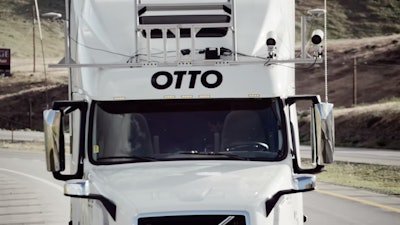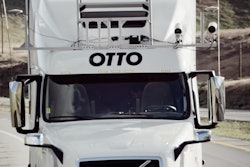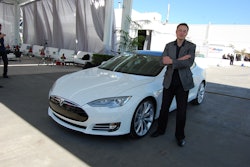
The future is here, and it looks driverless. But are autonomous vehicles really set to replace humans on our roadways?
According to the report, Identifying Autonomous Vehicle Technology Impacts on the Trucking Industry, released by the American Transportation Research Institute (ATRI) in November 2016, the deployment of autonomous vehicles in the trucking industry will rely heavily on the role the federal government chooses to take.
“The industry relies on an interstate highway system that facilitates the free flow of goods between the states. As autonomous technology is commercialized, it is critical that the state and local laws do not create disparities that limit commerce and obstruct the successful adoption of these potentially safety- and productivity-boosting technologies. It is critical that the federal government take a clear leadership role in autonomous technology deployment,” the report states.
The objective of the report was to “offer background on the current state of autonomous vehicle technology” and “to outline the impacts of autonomous technology deployment on the topics found within ATRI’s 2015 Top Industry Issues.” The report highlights a variety of changes and challenges associated with autonomous vehicle technology in an effort to help prepare the industry for a new trucking environment.
It is clear the development of autonomous vehicle technology and the regulations that go along with it are a top priority, as the Obama administration, during its final days in office, announced the creation of an advisory committee that will be tasked with setting rules for how self-driving cars and drones will operate on public roads and airways.
The committee will include leaders of major automotive and technology companies, including General Motors Chief Executive Mary Barra as co-chairman and executives at Amazon, Uber, Alphabet and FedEx among the 25 members.
A leader in autonomous vehicular technology, OTTO Motors, a division of Clearpath Robotics, predicts the market for self-driving vehicles to exceed $80 billion by 2030, making the need for self-driving material handling vehicles equally as significant.
Several factors are influencing the demand for autonomous vehicles, including a rapidly changing consumer market and an anticipated shortage of more than 2 million skilled workers in the U.S. over the next decade.
As labor rates rise in the U.S., as well as many parts of Europe and China, industrial outlets that do maintain labor in America are encountering higher turnover rates, while at the same time are having difficulty attracting talent to take the jobs within the warehouses.
“It's a bit of a double-edged sword, and self-driving vehicles are able to fill this gap and enable people to complete complex tasks and do the things that they tend to enjoy,” says Meghan Hennessey, marketing communications manager at OTTO Motors. “There's competitive landscape to consider–constant cost pressures for manufacturers and the fact that customers want product faster and cheaper than ever before. To achieve the higher levels of productivity, they've realized that we need to automate.”
IHS Automotive, a leading provider of detailed automotive market coverage, including analysis, data and insights, on component development, supply chain dynamics and technology, predicts that autonomous vehicles could reach 60,000 annually by 2035 or make up 15 percent of sales in the big Class 8 weight segment. Currently, there are about 3.46 million Class 8 trucks in the U.S., so if 60,000 autonomous trucks were added annually starting today, it would take more than five years to reach 10 percent of the fleet.
Looking at this estimate, it is fair to say that the widespread adoption of autonomous vehicles in the trucking industry remains in the distance. And though that means products may still be delivered by a human being, autonomous vehicles already are being used in various ways throughout the supply chain.
In October, Clearpath announced the completion of a $30 million investment in its industrial division, OTTO Motors, which it launched in 2015 to focus on self-driving vehicles for material transport inside manufacturing and warehouse operations.
“Factories operate like small indoor cities, complete with roads, traffic, intersections and pedestrians,” said Matt Rendall, CEO and co-founder of Clearpath, in an October press release. “Unlike city streets, a factory floor is a controlled environment, which makes it an ideal place to introduce self-driving vehicles at scale. Companies like Google, Telsa and Uber are still testing, whereas our self-driving vehicles are commercially available today.”
Companies such as GE and John Deere have implemented OTTO’s material handling equipment in their facilities.
“GE, their healthcare wing, is using the OTTO solution in their repair center to transport parts to work station cells, while John Deere is using OTTO for assembly line conveyance,” Hennessey notes.
OTTO offers two forms of self-driving vehicles designed exclusively for material transport in industrial sites. One is the OTTO 1500, which is made for heavy load material transport, and the other, OTTO 100, is made for light load material transport.
“It's something that this market hasn't really seen before, so we're excited to be there to give it to them,” Hennessey added.
Not to be confused with OTTO Motors, the Uber-owned Otto also has made great strides in the development of autonomous technology. Purchased by the ride-sharing company for $680 million in August, Otto does not build self-driving trucks, but instead focuses on making hardware kits, which can be installed relatively quickly on trucks at service centers or factories. The goal of the company over the next few years is for the technology to be used by truck drivers during long-haul drives to allow them to rest during the journey.
ATRI has identified several pieces of technology typically associated with autonomous vehicles, which when combined, have been used to produce autonomous systems. They include: radar, LIDAR, video camera systems, dedicated short-range communications, long-term evolution and differential global positioning systems.
An aftermarket autonomous system created by Otto utilizes a variety of the above mentioned technologies to retrofit existing vehicles. During an October 2016 demonstration of the system, a truck entered an interstate highway in Colorado while the driver of the truck placed the vehicle in self-driving mode, using Otto’s system. He then spent the remainder of the 120-mile trip in the truck’s sleeper cabin, thus establishing how the technology works and could be used in the near future.
In November 2016, a self-driving truck produced by Otto made a 35-mile trip along what Ohio Gov. John Kasich has deemed the “Smart Mobility Corridor.” The so-called smart road stretches along U.S. 33 in central Ohio and is said to be an area where autonomous technology can be safely tested in real-life traffic. A fiber-optic cable network and sensor system is slated for installation this summer.
Ohio’s smart road will be key to data collection needed to answer many questions that still remain in regards to autonomous technology.
Why self-driving?
We know self-driving vehicles could help solve an ongoing shortage in both drivers and skilled workers, but the additional impact they could have on the food and beverage industry remains to be seen.
One area of interest is overall productivity in the warehouse.
The technology has developed significantly in the last decade. Factories, distribution centers, warehouses, have always focused on continuous improvement and in order to gain those advances in productivity, the industry learned a long time ago that robotics and automation can provide the benefits that are needed, especially when it comes to material transport.
“Yeah, people can absolutely transport materials. They can use forklifts, they can use bikes; they can use tuggers. OTTO does it more efficiently to provide higher output and higher productivity for the organization,” says Hennessey.
And despite the capability of the technology currently available, many manufacturers or warehouses have not yet taken hold of this solution because up until this point in time, they've only been able to automate very specific tasks.
“That's why people continue to do a lot of the manual labor,” Hennessey explained. “When we look at the OTTO self-driving vehicle, we see they provide a level of flexibility that is a lot like people because they maintain onboard intelligence thanks to technology that has developed in systems like computers and sensors and perception in mapping.”
Hennessey added that anything that needs to be moved in a facility has the potential to be automated by a self-driving vehicle.
“Why not put those people in more high value roles and then have OTTO do that mundane travel for you?” she continued.
Lastly, Hennessey explained the obvious cost benefits associated with the implementation of self-driving vehicles in an industrial or manufacturing setting.
“It's obviously more cost effective for an organization to implement robotic vehicles or industrial robotics in general in their facility and what that allows, since they don't necessarily need as many people to run the plant, is the ability to locate their operations in more rural areas. They're not dependent on locating their operation close to where the people will be and then because they're going to be operating in more rural locations, that's going to impact their overhead costs as well and typically decrease them. When you're looking at taxes in the city of Chicago verses the greater area of Illinois, there's going to be a significant difference.”
Another area likely to be greatly impacted by self-driving vehicles is the trucking industry. Interstate transport companies who are struggling with a shortage of skilled drivers are likely to be early adopters of the technology, as well as large-scale logistics companies such as DHL who have massive warehouses and port facilities, where testing of the technology could reduce the risk of injury.
An annual study conducted by ATRI found the top 10 issues concerning commercial drivers in 2015. The list included: hours of service; compliance, safety and accountability; driver shortage; driver retention; parking; electronic logging device mandate; driver health and wellness; economy; infrastructure; and driver distraction.
Self-driving vehicles, to a degree, likely could solve many of these challenges.
Hours of service regulated the time a driver can work or drive. Drivers may be on-duty for up to 14 consecutive hours, drive up to 11 of those hours, and must rest at least 10 hours before returning to duty.
These regulations have drawn a lot of criticism from drivers for their lack of flexibility. ATRI’s November report concludes that the implementation of automated systems could be cause for a revision of the regulation, as they would “allow for increased flexibility and better rest for drivers” by permitting rest and productivity to occur simultaneously.
Speeding, reckless driving, improper lane change and the like are safety issues that autonomous vehicles could address. Though ATRI does not predict complete eradication of unsafe driving violations, “autonomous technology can be programmed not to violate traffic laws.”
This in turn would improve driver scores on the Federal Motor Carrier Safety Administration’s (FMCSA) BASICS scoring system, which monitors a company’s driver safety, for those who utilize autonomous systems.
Additionally the report states that the addition of autonomous vehicles could make the industry more desirable, which would help to address the driver shortage and retention issues.
Causes for concern
Though autonomous technology, such as OTTO’s material handling vehicles, is used in warehouses every day, for the trucking industry, there are still many unknowns in regards to safety. The research, however, overwhelming points to safer American highways.
Vehicle crashes result in nearly 30,000 death in the U.S. each year at a cost of $836 billion in relation to property damage and personal injury. The majority of crashes, research has shown, are due to human error. The National Highway Safety Traffic Administration (NHSTA) estimates 94 percent of crashes in 2015 are attributed to the driver.
Semiautonomous technologies, such as electronic stability control and forward collision systems, already have proven to improve a driver’s awareness and ability to operate safely. ATRI suggests that if 90 percent of cars on American roads were fully autonomous, the number of accidents per year could fall from 6 million to 1.3 million, and fatalities could decrease from 33,000 per year to 11,300.
“While these statistics do not specifically cite truck automation, it is likely that truck-car crashes would decrease as a result of car automation,” the report notes.
The report does cite a number of concerns that could result in liability issues. Those include scenarios where:
- A driver engages the driverless system in weather conditions that are not ideal for use of autonomous technologies.
- A self-driving vehicle suddenly stops for a nonexistent hazard due to a system glitch, causing a crash.
- A self-driving vehicle is hacked, resulting in a crash.
- A company is sued for additional negligence because they do not utilize self-driving technologies, which may be considered safer in the future.
Concerns that still are debated also include maintenance and repairs. “System failure could be catastrophic, particularly in systems where it is possible no human is present to take control of the vehicle,” says the report.
Additionally, regulations will be required not only for the use of autonomous vehicles but also for law enforcement who will require further tools and training.
Hennessey added that while OTTO Motors must adhere to a set of safety protocols designed specifically for material handling equipment, it is important that users of autonomous technology treat it like any other type of equipment.
“We want to make sure that the customers are getting proper safety training to use our self-driving vehicles to ensure they're used for their intended use, and of course, if they're being used properly, then they're going to be able to provide the most benefit for them.”




















